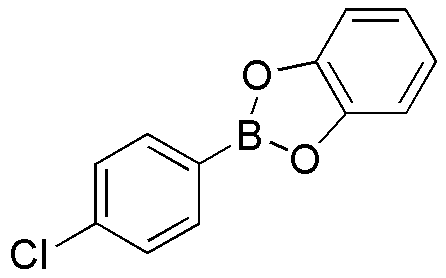4-Chlorophenylboronic acid, catechol cyclic ester is widely utilized in research focused on:
- Drug Development: This compound serves as a key building block in the synthesis of various pharmaceuticals, particularly in the development of anti-cancer agents that target specific cellular pathways.
- Organic Synthesis: It is employed in Suzuki coupling reactions, which are essential for forming carbon-carbon bonds in organic compounds, making it valuable in creating complex molecules for research and industrial applications.
- Bioconjugation: The compound is used in bioconjugation techniques, allowing researchers to attach biomolecules to surfaces or other molecules, enhancing the functionality of diagnostic tools and drug delivery systems.
- Sensor Technology: Its properties make it suitable for developing sensors that detect specific biomolecules, which is crucial in medical diagnostics and environmental monitoring.
- Material Science: This chemical is utilized in the production of advanced materials, including polymers and nanomaterials, which have applications in electronics and coatings due to their unique properties.
Información general
Propiedades
Seguridad y normativas
Aplicaciones
4-Chlorophenylboronic acid, catechol cyclic ester is widely utilized in research focused on:
- Drug Development: This compound serves as a key building block in the synthesis of various pharmaceuticals, particularly in the development of anti-cancer agents that target specific cellular pathways.
- Organic Synthesis: It is employed in Suzuki coupling reactions, which are essential for forming carbon-carbon bonds in organic compounds, making it valuable in creating complex molecules for research and industrial applications.
- Bioconjugation: The compound is used in bioconjugation techniques, allowing researchers to attach biomolecules to surfaces or other molecules, enhancing the functionality of diagnostic tools and drug delivery systems.
- Sensor Technology: Its properties make it suitable for developing sensors that detect specific biomolecules, which is crucial in medical diagnostics and environmental monitoring.
- Material Science: This chemical is utilized in the production of advanced materials, including polymers and nanomaterials, which have applications in electronics and coatings due to their unique properties.
Documentos
Hojas de datos de seguridad (HDS)
La SDS proporciona información de seguridad completa sobre la manipulación, el almacenamiento y la eliminación del producto.
Especificación del producto (PS)
La PS proporciona un desglose completo de las propiedades del producto, incluida la composición química, el estado físico, la pureza y los requisitos de almacenamiento. También detalla los rangos de calidad aceptables y las aplicaciones previstas del producto.
Certificados de análisis (COA)
Busque certificados de análisis (COA) ingresando el número de lote del producto. Los números de lote y de partida se pueden encontrar en la etiqueta de un producto después de las palabras "Lote" o "Lote".
Número de catálogo
Número de lote/lote
Certificados de origen (COO)
Este certificado de origen confirma el país en el que se fabricó el producto y también detalla los materiales y componentes utilizados en él y si se deriva de fuentes naturales, sintéticas u otras fuentes específicas. Este certificado puede ser necesario para cumplir con las normativas aduaneras, comerciales y regulatorias.
Número de catálogo
Número de lote/lote
Hojas de datos de seguridad (HDS)
La SDS proporciona información de seguridad completa sobre la manipulación, el almacenamiento y la eliminación del producto.
DownloadEspecificación del producto (PS)
La PS proporciona un desglose completo de las propiedades del producto, incluida la composición química, el estado físico, la pureza y los requisitos de almacenamiento. También detalla los rangos de calidad aceptables y las aplicaciones previstas del producto.
DownloadCertificados de análisis (COA)
Busque certificados de análisis (COA) ingresando el número de lote del producto. Los números de lote y de partida se pueden encontrar en la etiqueta de un producto después de las palabras "Lote" o "Lote".
Número de catálogo
Número de lote/lote
Certificados de origen (COO)
Este certificado de origen confirma el país en el que se fabricó el producto y también detalla los materiales y componentes utilizados en él y si se deriva de fuentes naturales, sintéticas u otras fuentes específicas. Este certificado puede ser necesario para cumplir con las normativas aduaneras, comerciales y regulatorias.


